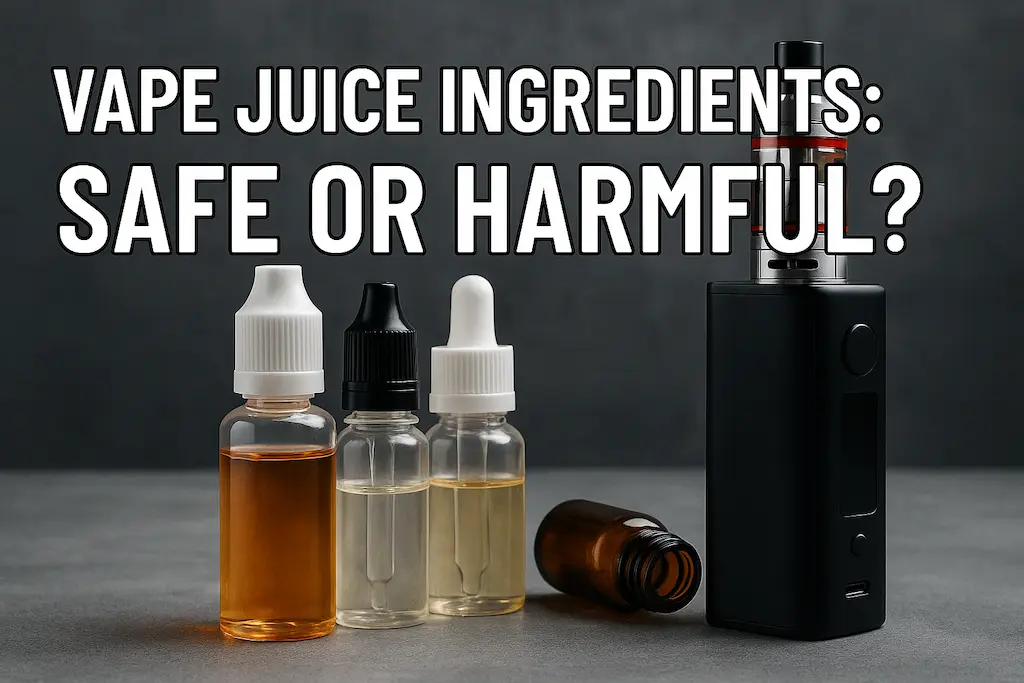Hej, det är Ethan här! Med 13 års erfarenhet av vaping under mitt bälte får jag den här frågan hela tiden: "Är ingredienser i vapejuice faktiskt säkra?" Med uppladdningsbara engångsvapor som trendar är jag här för att dela mina insikter baserat på min egen erfarenhet!
Vad finns i din Vape Juice?
Varje vapejuice innehåller fyra huvudingredienser: Propylenglykol (PG), vegetabiliskt glycerin (VG), nikotin och livsmedelsgodkända smakämnen. PG fungerar som en upplösare och ser till att allt blandas smidigt för en jämn vape. VG? Det är hemligheten bakom de tjocka, Instagram-värdiga molnen. Nikotin ger den tillfredsställande effekten, medan smakämnen förvandlar din vape till en explosion av smak - tänk vattenmelon mint eller karamell latte.
Är dessa ingredienser säkra?
Så här ligger det till: PG och VG finns i många av de livsmedel vi äter, från kakor till hostsirap. De flesta människor är bra, men om du upplever en torr hals eller hosta efter vaping, försök att byta till hög-VG-juice. Jag har sett den här lösningen fungera för otaliga vänner!
Nikotin är utan tvekan beroendeframkallande, men jämfört med tjäran och kolmonoxiden i cigaretter är vapes en enorm förbättring. Överdriv bara inte - en gång kedjevapnade jag juice med hög nikotinhalt och kände hur hjärtat rusade. Jag har lärt mig en läxa!
Välj alltid pålitliga varumärken för smakämnen. Billiga juicer utan namn kan vara katastrofala. Jag har sett vänner få halsinfektioner - det är definitivt inte värt risken.
Är uppladdningsbara Vape för engångsbruk Juicer mer riskfyllda?
Jag vet vad du tänker: "Eftersom dessa uppladdningsbara engångsvapes är så populära, är deras juicer farligare? Spoilervarning: nej! Säkerheten för vapejuice är inte relaterad till om din enhet är uppladdningsbar eller engångsbruk. Det handlar om kvaliteten på ingredienserna och om produkten har rätt certifieringar.
Dessa uppladdningsbara engångsartiklar förändrar spelplanen genom att erbjuda lång batteritid och eliminera behovet av påfyllning. Men innan du köper, gör din hemläxa. Kontrollera varumärkets rykte och leta efter certifieringar som TPD i Europa eller FDA-överensstämmelse i USA. Jag dubbelkollar alltid dessa detaljer, och de har räddat mig från att göra några tvivelaktiga köp.
Långsiktiga risker med vaping
Jag kommer inte att sugarcoat det: vaping är inte 100% säkert. Även efter 13 år måste jag fortfarande påminna mig själv om detta. En gång överdoserade jag på juice med hög nikotinhalt. Det var en väckarklocka. Långvarig nikotinanvändning kan höja ditt blodtryck och konstant exponering för PG och VG kan irritera dina luftvägar. För mer information, vänligen se artikeln "Hälsoeffekter av vaping."
Om du är lika beroende av vaping som jag är, försök att skära ner. Och om du kan sluta helt och hållet, ännu bättre. Jag har själv funderat på att ta en paus. Jag vet att det inte kommer att bli lätt, men vår hälsa bör alltid komma i första hand.
Mina bästa tips för säker Vape Juice
Det här är mina beprövade knep:
- Läs etiketten: Titta efter tydliga ingrediensförteckningar, nikotinstyrka och utgångsdatum. Saknas information? Gå iväg.
- Håll dig till välrenommerade varumärken: Jag har använt e-vätskor från märken som Vaporesso och SMOK, som har funnits i e-cigarettbranschen i över 10 år, sedan 2018, och de är mina favoritmärken. För uppladdningsbara vapes rekommenderar jag Fumot och Bang serie.
- Hoppa över fynden: Billiga juicer använder ofta ingredienser av låg kvalitet. Din hälsa är värd de extra pengarna.
Fortfarande osäker? Gå till Reddits vaping-communities eller titta på YouTube-recensioner för mer information. Riktiga vapers delar sina rekommendationer och varningar om de bästa och värsta produkterna. Jag hoppas att det här hjälper! Ställ dina frågor nedan, så svarar jag på dem alla!
När e-vätska och coils arbetar i harmoni är den sista biten i inhalationspusslet droppspetsen - den del som kopplar dig till ångan. Droppspetsen är ofta förbisedd, men den påverkar luftflödet, temperaturen och till och med smakrenheten. Härnäst ska vi utforska hur dess storlek, material och design gör ett enkelt bloss till en personlig upplevelse. Relaterad artikel: "Droppspets: Vape Experience Tuner - Storlek, material och köptips".
